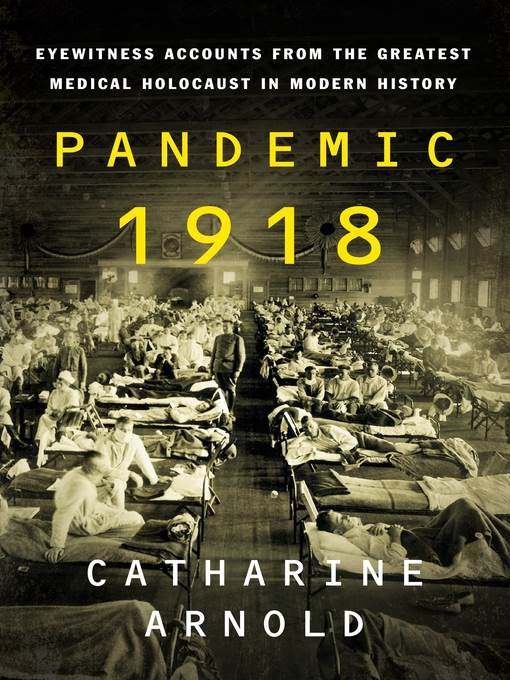
Pandemic 1918
Eyewitness Accounts from the Greatest Medical Holocaust in Modern History
شاهدان عینی از بزرگترین هولوکاست پزشکی در تاریخ مدرن سخن میگویند.
کتاب های مرتبط
- اطلاعات
- نقد و بررسی
- دیدگاه کاربران
نقد و بررسی

June 1, 2018
Arnold (Globe: Life in Shakespeare's London, 2015, etc.) collects global eyewitness accounts of Spanish flu, clearly illustrating why it caused more deaths than World War I.The virus began in early 1918 and wreaked havoc around the world until summer 1919. It was considered a bacterial infection, and few questioned it since other diseases--e.g., cholera and plague--were bacterial. The modern concept of the virus was unknown in 1918, and the world war helped to create a perfect storm of factors that fed the virus. A massive military base in northern France housed a port, railway yards, stores, prisons, training areas, stables, and piggeries as well as areas to house ducks, geese, and chickens to feed the army. Ducks were a reservoir for bird flu viruses, and their feces would be absorbed by the other animals that were kept for food. Nearby was a general hospital, and 100 trains per day brought wounded from the front to be treated by up to 10,000 medical staff. This was where the first case appeared. The wounded were repatriated or returned to the front, carrying the disease throughout Europe. In America, a case appeared on a Kansas farm, and then an overcrowded Army camp in Kansas witnessed outbreak. The first appearances were spotty; most patients recovered, and it vanished as quickly as it appeared. Not so the second wave in the summer, as the author amply shows, when it struck with a deadly virulence. Any large gathering was potentially deadly, including massive troop movements, bond drives, and victory parades not to mention troop ships, which became floating incubators. It was an unusual flu in that it arrived in summer rather than winter and struck the young and fit rather than the old and infirm. By the time it passed, it had killed one-third of the world's population. A wealth of stories of gruesome infection, lack of health care, and further transmission. A well-researched but ugly history that may fatigue readers by the end.
COPYRIGHT(2018) Kirkus Reviews, ALL RIGHTS RESERVED.

Starred review from July 2, 2018
Arnold’s grim compilation of accounts of the Spanish flu that killed upwards of 100 million people in 1918–19 vividly evokes the tragedy. Starting with a potential “Patient Zero,” Pvt. Harry Underdown, Arnold tracks the relentless march of the virus across the globe. It struck healthy young men and women in an “innocuous” first wave in the early spring of 1918; this was followed by a stunningly virulent second wave in the fall, its spread aided by mass WWI troop gatherings and movements. Katherine Anne Porter and Thomas Wolfe wrote of the destruction in fiction; New Yorker editor William Maxwell bemoaned the death of his mother and newborn sibling as a time when “there was a sadness which had not existed before”; the horrified commander of a sickened regiment aboard a troop ship heading for France called the illness “a true inferno” that “reigned supreme.” Arnold recounts how the flu devastated Philadelphia, where more than 7,000 died in two weeks of October 1918, creating a shortage of undertakers and caskets. “There were no medicines, no doctors, nothing people could do to heal themselves,” one desperate survivor recalled. This well-researched and often overwhelming history serves as a stark warning of the threat of pandemic flu. Agent: Andrew Lownie, Andrew Lownie Literary.

Starred review from August 1, 2018
One hundred years have passed since the deadliest pandemic in history. From 1918 to 1919, the Spanish flu claimed the lives of more than 50 million people worldwide. Drawing from a robust bibliography, historian Arnold presents a collection of essays that colorfully illustrate the everyday impact of the disease, drawing from personal narratives while also citing references in the medical literature as the outbreak was unfolding. Alternating perspectives are presented as each chapter highlights a distinct population as the disease spread in waves across continents. Much of the text focuses on the challenges that World War I posed on containing the flu, with conditions among the soldiers exacerbating the spread of communicable disease. Depictions include U.S. and European army barracks, troop ships, such as the USS Leviathan, and military hospitals. VERDICT An enjoyable read using easily understood terms. Recommended for public health professionals, historical medicine readers, world history buffs, and historical fiction fans.--Carolann Curry, Mercer Univ. Lib., Macon, GA
Copyright 2018 Library Journal, LLC Used with permission.

August 1, 2018
One hundred years after the Spanish Flu scoured the globe, killing 50 million people worldwide, popular historian Arnold (Necropolis) offers a history of the pandemic and its far-ranging consequences.
Copyright 2018 Library Journal, LLC Used with permission.

























دیدگاه کاربران